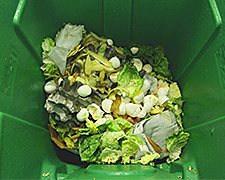As municipal food composting programs spread across North America and Europe, no city faces a more daunting task than New York. Its Department of Sanitation collects more than 10,000 tons of trash every day, and another 1,700 tons of recyclable materials. A large portion of that waste, though, may soon have a future other than the landfill: Food scraps and other “organics” have long been just a part of New York’s trash pile, but a pilot program in the city is aimed at rolling out collection of that material and composting it, a far more environmentally friendly method.
“It’s the next new thing in terms of municipal waste handling in the 21st century,” says Eric Goldstein, a senior attorney with the Natural Resources Defense Council (NRDC) in New York. “Right now… there are over 150 communities throughout the United States that are collecting organics at curbside. It’s a national trend. It’s revolutionary.”
Many of those programs are still voluntary, and the bulk are in small cities and towns. But larger cities in North America — including San Francisco, Seattle, San Antonio, Toronto, and Portland, Ore. — are moving rapidly ahead. And municipal composting efforts in many European countries are far advanced and steadily growing. In 2011, the 27 states in the European Union composted on average 15 percent of municipal waste, with Austria composting 34 percent, the Netherlands 28 percent, and countries like France, Spain, and Germany each composting about 18 percent.
‘We spend over $85 million a year sending food waste to landfills,’ says a New York City official.
In New York Mayor Michael Bloomberg’s State of the City address this past February, he called food waste the city’s “final recycling frontier,” which holds true for the rest of the United States, as well. According to the U.S. Environmental Protection Agency (EPA), the country as a whole produced 250 million tons of municipal solid waste in 2011, and compostable materials — which include yard trimmings, paper and paperboard, as well as food waste — comprised the largest component of that at 56 percent.
The environmental benefits of recycling that material are significant. As it decomposes in landfills, food and other organic waste produces methane, a greenhouse gas 25 times more powerful than carbon dioxide. According to the EPA, landfills are the third-largest source of methane in the United States, behind industry and agriculture. Shipping waste long distances from cities to landfills produces even more greenhouse gas emissions. Composting, meanwhile, takes that waste and turns it into something usable: fertilizer. If cities like New York want to cut emissions, cut waste, and even cut costs, composting is a proven way to go about it.
The good news is that of the 87 million tons of “recovered” waste in the U.S. in 2011 — meaning waste that did not end up in a landfill — organic material accounted for the largest component. But most of that material was paper; food waste accounted for only 1.6 percent of the recovered total versus 14.5 percent of the generated total, the EPA says. The U.S. does a reasonably good job of keeping paper out of landfills thanks to recycling programs, but food almost universally still goes where it shouldn’t.

New York is trying to change that with its new program. So far, compost collection is being offered in one neighborhood of Staten Island, and city officials say that after only a few months participation rates are above 40 percent. Contamination rates — meaning, the presence of non-compostable material in the compost bin — are at 1 percent or below. In Manhattan, about 100 city schools are also participating, with a goal of spreading to 400 schools by the end of the year. Two high-rise apartment buildings are included as well, with more to follow this fall.
“We spend over $85 million a year sending food waste to landfills, so there’s a major cost,” said Ron Gonen, New York City’s deputy commissioner for recycling and sustainability, who heads up the composting program. He said so far the program is collecting at a pace on the order of “tens of thousands” of tons per year. “It’s growing every day,” said Gonen. “We’re going to continue to expand, in all five boroughs.” By 2014 the program will cover around 100,000 households.
Goldstein says that if New York demonstrates the economic and logistical viability of its program it could be a “bellwether” in the push to expand composting nationwide. But a few cities — in general, the green, progressive ones you might expect — have already taken the lead over the last decade. San Francisco — the second-densest large city in the U.S. after New York — is considered the frontrunner, thanks to legislation in 2002 that set a goal of diverting 75 percent of its waste from landfills by 2010 and achieving “zero waste” by 2020.
San Francisco’s composting program began with restaurants and other businesses, and in 2009 an ordinance made it mandatory for all residents to separate organic material for collection. Instead of two bins to set out on the curb for trash and recyclables, there are now three. The green compost bins can include all food scraps, no matter how spoiled, along with vegetation from yards like leaves and flowers, and solid paper products including coffee cups, waxy paper, milk cartons, and related items. The city collected its millionth ton of organic waste for composting last fall. Overall, 78 percent of San Francisco’s waste is now diverted from landfills.
In the European Union, 40 percent of waste is now composted or recycled.
Seattle has a similar program, as does Portland; the latter went a step further and scaled back residential garbage pickup to only once every two weeks when the weekly compost pickup began.
Despite some early resistance and confusion — much of it related to every-other-week garbage collection — a survey in Portland found that 66 percent of residents rated the city’s recycling and composting program as “good” or “very good” after one year, with another 20 percent neutral on the issue. Along with the positive reception, there has been clear progress: In the 12-month period prior to the October 2011 start of the composting program, 94,100 tons of garbage were collected. In the following 12 months, that figure fell to 58,300 tons. Meanwhile, collections of compostable material rose from 30,600 tons to 85,400 tons, a figure that includes yard waste.
There were questions early on about vermin, but moving the scraps from the garbage can to the compost bin doesn’t change much, said Bruce Walker, Portland’s solid waste and recycling program manager. The organic material in Portland travels to one of two facilities that are 15 and 90 miles from downtown. Walker said regular garbage gets trucked much farther, about 140 miles from the city, so the environmental savings are compounded. The composting facilities produce fertilizers that are sold to farms, tree nurseries, and to the general public.
In Europe, the European Landfill Directive requires European Union member states to reduce “biodegradable municipal waste” sent to landfills to 35 percent of 1995 amounts by 2016. In the EU, 40 percent of waste is now composted or recycled, with 23 percent incinerated and 37 percent landfilled. Norway, Sweden, the Netherlands, Denmark, Switzerland, Belgium, Austria, and Germany now send less than 3 percent of their waste to landfills. Copenhagen, one of the greenest cities in the world, stopped sending organic waste to landfills as far back as 1990.
‘Ultimately, there’s going to be very little left in the traditional garbage can,’ says one official.
Other European countries lag far behind, with Greece and eastern European nations such as Bulgaria, Lithuania, and Romania doing almost no composting. Still, some of the swiftest progress has come from some former eastern bloc countries like Estonia. The capital city of Talinn has been collecting biodegradable kitchen waste separately since 2007, part of the reason why landfill rates in Estonia have dropped from close to 100 percent 15 years ago to below 60 percent today. Europe is also much farther along than the U.S. in using anaerobic digestion, a process that takes organic waste and turns it into biogas, which can be used to generate electricity.
MORE FROM YALE e360
To Tackle Runoff, Cities Turn to Green Initiatives

In New York, the question of where to bring collected organic material is unresolved. The city has a request for proposals to build a new composting plant in or close to the city, but until then there aren’t nearby facilities that can handle large amounts. Goldstein, of the NRDC, said that one possibility is to site facilities outside the city or partner with farms in the Catskills — sending the material 75 miles or so is still a huge improvement on the current system, which involves exporting to landfills sometimes many states and hundreds of miles away.
“The city has been really slow in terms of going through this process,” said Christine Datz-Romero, co-founder and executive director of the Lower East Side Ecology Center, which has worked on composting in New York for two decades. “If we wanted a facility here in New York City we should have started that process a long time ago. For building a facility we’re talking years. I see that as the biggest stumbling block because right now we have very limited capacity.”
Should New York and numerous other U.S. cities and towns establish vibrant composting programs, the environmental benefits will be enormous, advocates say. “Ultimately, there’s going to be very little left in the traditional garbage can,” said Goldstein.